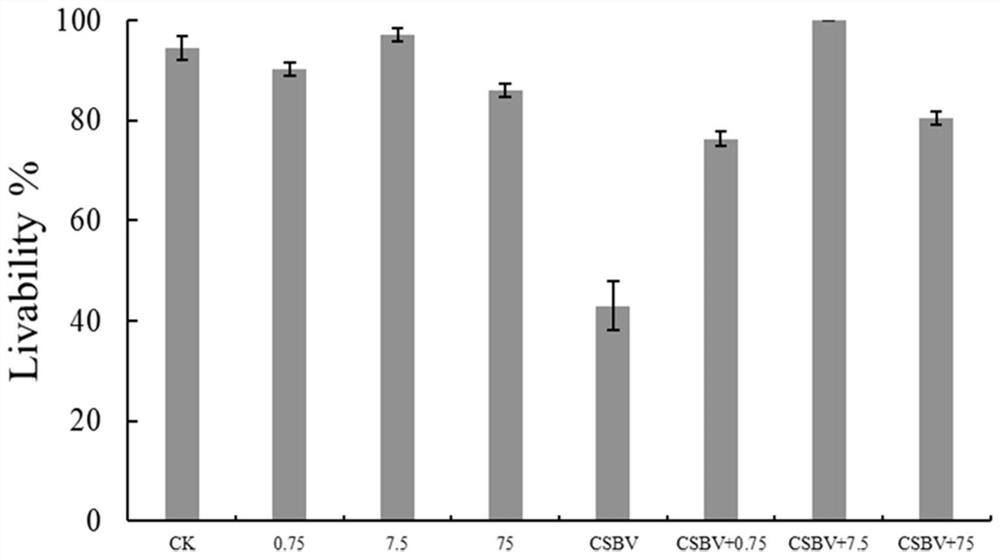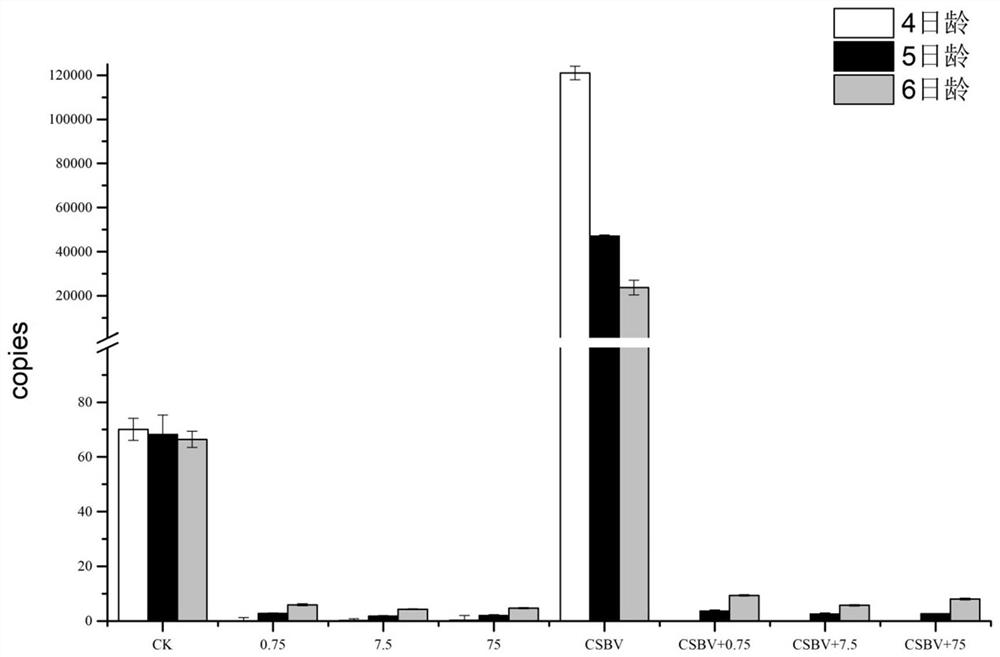The application of adenosine in the prevention and treatment of honey bee virus infection
A bee and adenosine technology, applied in the field of bee breeding, can solve the problems of low production efficiency, high production cost, and restriction of mass production of antimicrobial peptides, and achieve the effects of improving survival rate, reducing copy number, and contributing to normal growth and development.
- Summary
- Abstract
- Description
- Claims
- Application Information
AI Technical Summary
Problems solved by technology
Method used
Image
Examples
Embodiment 1
[0043] Example 1 Utilizing adenosine to intervene healthy Chinese bee larvae and poisoned larvae
[0044] 1. Samples for testing
[0045] Apis cerana comes from the experimental bee colony of the Honey Bee Research Institute of the Chinese Academy of Agricultural Sciences. In order to obtain 2-day-old larvae, the queen bee was kept on the spleen to lay eggs for 96 hours, and the 2-day-old larvae were taken out from the colony and placed in a 24-well plate, placed in a temperature of 32±1°C and relative humidity. Perform pre-cultivation in a constant temperature and humidity incubator at 75±5% RH.
[0046] Reverse transcription-polymerase chain reaction (RT-PCR) method was used to detect the existence of CSBV and other viruses in the test larvae (including black queen bee virus BQCV, defective virus DWV, Israeli paralysis virus IAPV, Kashmir virus KBV, acute paralysis virus ABPV, For chronic paralysis virus (CBPV) infection, healthy larvae without virus infection are used as ...
experiment example 1
[0067] Experimental example 1 Analysis of the survival rate and mortality of healthy larvae and infected larvae after adenosine intervention
[0068] 1. Survival rate
[0069] Survival rate statistics are carried out to each group of honeybee larvae in embodiment 1, and the results are as follows: figure 1 As shown, the results showed that the survival rate of larvae in the CK group and the preparation group fed conventionally could reach more than 86%, indicating that adenosine intervention would not cause abnormal death of healthy larvae and would not affect the growth and development of healthy larvae.
[0070] A large number of larvae in the infection group died, and the survival rate was only 43%. The survival rate of the larvae in the intervention group was significantly increased to more than 76%. Among them, the low concentration group (0.75 μg / mL) intervened in the 6-day-old larvae and all survived. The results showed that using Adenosine intervention can save about ...
experiment example 2
[0078] Experimental example 2 Detection of virus copy number after adenosine intervention in healthy larvae and infected larvae
[0079] CSBV detection is carried out to the apparently healthy 4-6 day-old Chinese bee larvae (CK group) in Example 1, and it is found that the virus copy number of each day-old larva is 66-70, indicating that the apparently healthy larvae also have virus infection, but did not show obvious symptoms, indicating that CSBV is generally invisible to infection in bee colonies, and the larvae can survive with the virus within a certain concentration, which is consistent with Liu Shan (Shan, L., Liuhao, W., Jun, G., Yujie ,T.,Yanping,C.,Jie,W.,Jilian,L.,Chinese Sacbrood Virus Infection in Asian Honey Bees(Apis cerana cerana)and HostImmune Responses to the Virus Infection,Journal of Invertebrate Pathology.2017,doi:http: / / dx.doi.org / 10.1016 / j.jip.2017.09.006) are consistent with the research results. After adenosine intervention, the virus copy number in ...
PUM
 Login to View More
Login to View More Abstract
Description
Claims
Application Information
 Login to View More
Login to View More - R&D
- Intellectual Property
- Life Sciences
- Materials
- Tech Scout
- Unparalleled Data Quality
- Higher Quality Content
- 60% Fewer Hallucinations
Browse by: Latest US Patents, China's latest patents, Technical Efficacy Thesaurus, Application Domain, Technology Topic, Popular Technical Reports.
© 2025 PatSnap. All rights reserved.Legal|Privacy policy|Modern Slavery Act Transparency Statement|Sitemap|About US| Contact US: help@patsnap.com



